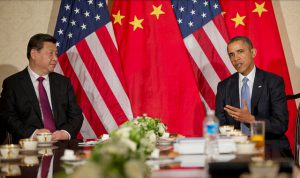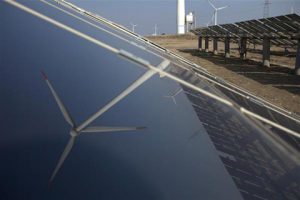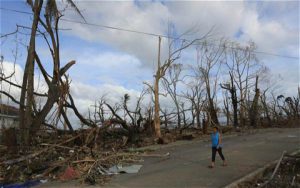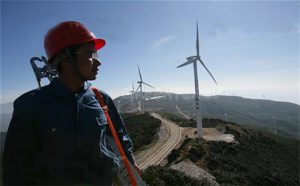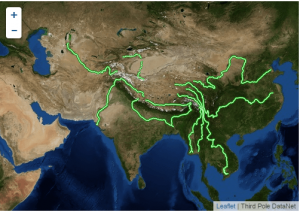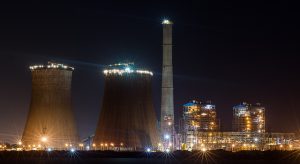The US administration sees climate change at, or near, the top of its bilateral agenda with China – despite the domestic setback for environmental issues caused by the Democratic Party’s ringing defeat in Tuesday’s Congressional elections. The expectation is that president Barack Obama will use his upcoming meeting with Chinese President Xi Jinping during the APEC summit in Beijing to create momentum for the UN climate talks in Lima in December, and ultimately the international climate conference in Paris next year.
Climate-change cooperation was a bright spot in US-China relations in an otherwise dark year, dominated by territorial disputes in the South China Sea, cyber spying and democracy protests in Hong Kong. “It is one of the few areas where we are likely to see more agreement than disagreement,” says Joanna Lewis, an associate professor of science, technology and international affairs at Georgetown University. “There will be pressure on both sides to have a positive deliverable.”
Prior to his departure for meetings in Beijing, US secretary of state John Kerry called on both countries to “lead the world with genuine reductions”.
Today, the US and China are in a much better position to come to a meaningful agreement than during the Copenhagen summit in 2009. Since then both sides have taken steps to counter climate change domestically. China is under pressure to react to almost apocalyptic levels of air pollution and its leadership is debating a cap on carbon emissions for its next five-year development plan. In the US, Obama has worked around a reluctant Congress by using the Environmental Protection Agency in an attempt to cut emissions. The White House stressed that the president will continue to do so even after Republicans increased their grip over Congress.
Cooperation so far
Perhaps most importantly, both sides have built mutual trust through numerous bilateral initiatives. For example, the Climate Change Working Group is developing projects that range from reducing vehicle emissions to developing smart-grid technologies and enhancing energy efficiency in buildings.
The meeting in Beijing is likely to bring an update on bilateral collaboration to phase down hydrofluorocarbons (HFCs), agreed by Obama and Xi at their summit in Sunnylands, California last year. Since then, manufacturers on both sides have been working to develop air conditioners and refrigerators with lower levels of greenhouse-gas emissions.
“Both sides have done a very good job in finding areas that are in the mutual interest of both countries,” says Pete Ogden, the director for international energy and climate policy at the Center for American Progress, who worked on climate change at the State Department and the White House between 2009 and 2013. He believes that the ongoing exchange and cooperation since 2009 has created a better atmosphere for negotiating a new international accord on climate change.
Ogden is also convinced that the Copenhagen accord, often described as a failure for its lack of enforceability, has set the groundwork for a more ambitious follow-up in Paris. Unlike the 1997 Kyoto Agreement, the contract was not binding under international law. But while the biggest emitters, the US and China, stayed outside of Kyoto, they entered the global climate regime in Copenhagen.
“For the first time, we have an agreement in which all major economies are represented,” says Ogden. He also points to the Climate Fund, into which rich countries can pledge money to help poorer countries to adapt to climate change. “We go into Paris with all of that in existence, and we don’t need to hash out the structure for the first time.”
The US and China can build on the results in Copenhagen which require countries to state their own targets and account for progress. “And though politically rather than legally binding, countries are working hard to meet those targets. Anyone who doubts this should take a look at the intensive effort under way in countries like the United States and China,” the US special envoy for climate change Todd Stern said in a recent speech at Yale University.
China waiting for US commitments
But even though the domestic developments on both sides have been encouraging, doubts remain as to whether they can be translated into a successful global agreement. So far, China shows no sign of backing off from its position that different standards should apply for developing and developed countries.
Jake Schmidt, director of the international programme at the Natural Resources Defense Council, believes that the Chinese leadership will want to wait and see what the US brings to the table before declaring a peak year for its own emissions. The challenge for the US side will be to persuade others that further emission cuts will be possible in the face of political resistance to climate change action at home.
Climate-change activists tried in vain to reintroduce the issue into the debate during this Congressional election cycle. Hedge fund billionaire Tom Steyer and other green groups had poured $85 million into propping up vulnerable Democrats with climate-friendly positions, but most of them lost their seats on election night.
The result does not change the political reality in Washington, where legislative action on climate change has not been a realistic option since 2009. “Republican or Democrat, the votes were not there,” says NRDC’s Schmidt. “But the president has a lot of tools to drive deep reductions in carbon emissions without having to go back to Congress.”
Obama has taken administrative action through the Environmental Protection Agency (EPA) by setting fuel-efficiency standards for cars and limits for coal-plant emissions. Mitch McConnell, the new Republican majority leader in the Senate has vowed to defund the EPA and to protect his state Kentucky from the President’s “war on coal”. But climate-change activists say that there is little Republicans can do to repeal the measures since they were taken under the provisions of an existing law, the Clean Air Act.
But perceptions also matter, and it is certain that Obama will go into the next climate talks with little political backing. While the US is on the way to reach its target of meeting emissions by 17% below 2005 levels in 2020, there will be doubts as to how much more ambitious it can get without national legislative action on issues such as cap and trade.
“The challenge for the US will be to articulate to the international community how they will be able to meet targets in the absence of Congressional legislation,” says Lewis. The next months will show how far the mutual trust built up since Copenhagen can carry the US and China on the road to Paris.
